2 Pallas
Pallas (minor-planet designation: 2 Pallas) is the second asteroid to have been discovered, after 1 Ceres. It is one of the largest asteroids in the Solar System, and is a likely remnant protoplanet. With an estimated 7% of the mass of the asteroid belt, it is the third-most-massive (and third-largest) asteroid, being three quarters the mass of 4 Vesta and one quarter the mass of Ceres. It is about 510 kilometers (320 mi) in diameter, slightly smaller than Vesta.
 VLT-SPHERE image of Pallas[1] | |
| Discovery [2] | |
|---|---|
| Discovered by | Heinrich Wilhelm Olbers |
| Discovery date | 28 March 1802 |
| Designations | |
| (2) Pallas | |
| Pronunciation | /ˈpæləs/[3] |
Named after | Pallas Athena (Greek goddess)[4] |
| asteroid belt · (central) Pallas family [5] | |
| Adjectives | Palladian /pæˈleɪdiən/ [6] |
| Orbital characteristics [7] | |
| Epoch 31 May 2020 (JD 2459000.5) | |
| Uncertainty parameter 0 | |
| Observation arc | 198.29 yr (72,427 d) |
| Earliest precovery date | 1779 |
| Aphelion | 3.411748055±0.000000005 AU |
| Perihelion | 2.13593481±0.00000009 AU |
| 2.773841434±0.000000004 AU | |
| Eccentricity | 0.22997227±0.00000003 |
| 4.62 yr (1687.410991±0.000004 d) | |
| 334.32° | |
Mean motion | 0° 12m 48.041s / day |
| Inclination | 34.832932°±0.000003° (34.21° to invariable plane[8]) |
| 173.024741°±0.000006° | |
Argument of perihelion | 310.202392°±0.000009° |
| Proper orbital elements[9] | |
Proper semi-major axis | 2.7709176 AU |
Proper eccentricity | 0.2812580 |
Proper inclination | 33.1988686° |
Proper mean motion | 78.041654 deg / yr |
Proper orbital period | 4.61292 yr (1684.869 d) |
Precession of perihelion | −1.335344 arcsec / yr |
Precession of the ascending node | −46.393342 arcsec / yr |
| Physical characteristics | |
| Dimensions | 550 km × 516 km × 476 km[10] |
Mean diameter | 512±6 km[10] |
| (8.3±0.2)×105 km2[lower-alpha 1][11] | |
| Volume | (7.1±0.3)×107 km3[lower-alpha 1][12] |
| Mass | (2.01±0.13)×1020 kg[lower-alpha 2][13] |
Mean density | 2.57±0.19 g/cm3[13] |
Equatorial surface gravity | ≈ 0.21 m/s² (average)[lower-alpha 3] 0.022 g |
Equatorial escape velocity | ≈ 0.33 km/s[lower-alpha 3] |
| 7.8132 h[14] | |
Equatorial rotation velocity | 65 m/s[lower-alpha 1] |
| 84°±5°[10] | |
Geometric albedo | 0.159[15] |
| B[7][16] | |
| 6.49[17] to 10.65 | |
| 4.13[15] | |
| 0.629″ to 0.171″[18] | |
When Pallas was discovered by the German astronomer Heinrich Wilhelm Matthäus Olbers on 28 March 1802, it was counted as a planet,[19] as were other asteroids in the early 19th century. The discovery of many more asteroids after 1845 eventually led to their reclassification.
Pallas's surface is most likely composed of a silicate material; its spectrum and estimated density resemble carbonaceous chondrite meteorites. With an orbital inclination of 34.8°, Pallas's orbit is unusually highly inclined to the plane of the asteroid belt, making Pallas relatively inaccessible to spacecraft, and its orbital eccentricity is nearly as large as that of Pluto.[20]
It was considered as a potential dwarf planet in 2006, but it has since been determined that its shape departs significantly from an ellipsoid, thus disqualifying it.[10]
History
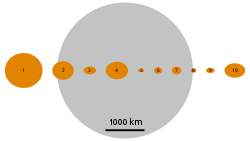
Discovery
On the night of 5 April 1779, Charles Messier recorded Pallas on a star chart he used to track the path of a comet (now known as C/1779 A1 (Bode)) that he observed in the spring of 1779, but apparently assumed it was nothing more than a star.[21]
In 1801, the astronomer Giuseppe Piazzi discovered an object which he initially believed to be a comet. Shortly thereafter he announced his observations of this object, noting that the slow, uniform motion was uncharacteristic of a comet, suggesting it was a different type of object. This was lost from sight for several months, but was recovered later that year by the Baron von Zach and Heinrich W. M. Olbers after a preliminary orbit was computed by Carl Friedrich Gauss. This object came to be named Ceres, and was the first asteroid to be discovered.[22][23]
A few months later, Olbers was again attempting to locate Ceres when he noticed another moving object in the vicinity. This was the asteroid, Pallas, coincidentally passing near Ceres at the time. The discovery of this object created interest in the astronomy community. Before this point it had been speculated by astronomers that there should be a planet in the gap between Mars and Jupiter. Now, unexpectedly, a second such body had been found.[24] When Pallas was discovered, some estimates of its size were as high as 3,380 km in diameter.[25] Even as recently as 1979, Pallas was estimated to be 673 km in diameter, 26% greater than the currently accepted value.[26]
The orbit of Pallas was determined by Gauss, who found the period of 4.6 years was similar to the period for Ceres. Pallas has a relatively high orbital inclination to the plane of the ecliptic.[24]
Later observations

In 1917, the Japanese astronomer Kiyotsugu Hirayama began to study asteroid motions. By plotting the mean orbital motion, inclination, and eccentricity of a set of asteroids, he discovered several distinct groupings. In a later paper he reported a group of three asteroids associated with Pallas, which became named the Pallas family, after the largest member of the group.[28] Since 1994 more than 10 members of this family have been identified, with semi-major axes between 2.50–2.82 AU and inclinations of 33–38°.[29] The validity of the family was confirmed in 2002 by a comparison of their spectra.[30]
Pallas has been observed occulting stars several times, including the best-observed of all asteroid occultation events, by 140 observers on 29 May 1983. These measurements resulted in the first accurate calculation of its diameter.[31][32] After an occultation on 29 May 1979, the discovery of a possible tiny satellite with a diameter of about 1 km was reported, which was never confirmed.
Radio signals from spacecraft in orbit around Mars and/or on its surface have been used to estimate the mass of Pallas from the tiny perturbations induced by it onto the motion of Mars.[33]
The Dawn team was granted viewing time on the Hubble Space Telescope in September 2007 for a once-in-twenty-year opportunity to view Pallas at closest approach, to obtain comparative data for Ceres and Vesta.[34][35]
Naming
2 Pallas is named after Pallas Athena (Ancient Greek: Παλλάς Ἀθηνᾶ), an alternate name for the goddess Athena.[36][37] In some versions of the myth, Athena killed Pallas, then adopted her friend's name out of mourning.[38]
The adjectival form of the name is Palladian.[6] The d is part of the oblique stem of the Greek name, which appears before a vowel but disappears before the nominative ending -s. The oblique form is seen in the Italian and Russian names for the asteroid, Pallade and Паллада Pallada.[39]
(There are several male characters with a similar same name in Greek mythology, Pállas rather than Pallás, but the first asteroids were invariably given female names. Because the oblique stem is different, the male name would have been Pallante in Italian and Паллант Pallant in Russian.)
The stony-iron Pallasite meteorites are not Palladian, being named instead after the German naturalist Peter Simon Pallas. The chemical element palladium, on the other hand, was named after the asteroid, which had been discovered just before the element.[40]
As with other asteroids, the astronomical symbol for Pallas is a disk with its discovery number, ②. It also has an older, more iconic symbol, ⚴ (![]()
![]()
Orbit and rotation

Pallas has unusual dynamic parameters for such a large body. Its orbit is highly inclined and moderately eccentric, despite being at the same distance from the Sun as the central part of the asteroid belt. Furthermore, Pallas has a very high axial tilt of 84°, with its north pole pointing towards ecliptic coordinates (β, λ) = (30°, −16°) with a 5° uncertainty in the Ecliptic J2000.0 reference frame.[10] This means that every Palladian summer and winter, large parts of the surface are in constant sunlight or constant darkness for a time on the order of an Earth year, with areas near the poles experiencing continuous sunlight for as long as two years.[10]
Near resonances
Pallas is in a, likely coincidental, near-1:1 orbital resonance with Ceres.[41] Pallas also has a near-18:7 resonance (91,000-year period) and an approximate 5:2 resonance (83-year period) with Jupiter.[42]
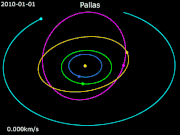 Animation of the Palladian orbit in the inner Solar system
Animation of the Palladian orbit in the inner Solar system
· Pallas
· Ceres
· Jupiter
· Mars
· Earth
· Sun- An animation of Pallas's near-18:7 resonance with Jupiter. The orbit of Pallas is green when above the ecliptic and red when below. It only marches clockwise: it never halts or reverses course (i.e. no libration). The motion of Pallas is shown in a reference frame that rotates about the Sun (the center dot) with a period equal to Jupiter's orbital period. Accordingly, Jupiter's orbit appears almost stationary as the pink ellipse at top left. Mars's motion is orange, and the Earth–Moon system is blue and white.
Transits of planets from Pallas
From Pallas, the planets Mercury, Venus, Mars, and Earth can occasionally appear to transit, or pass in front of, the Sun. Earth last did so in 1968 and 1998, and will next transit in 2224. Mercury did in October 2009. The last and next by Venus are in 1677 and 2123, and for Mars they are in 1597 and 2759.[43]
Physical characteristics
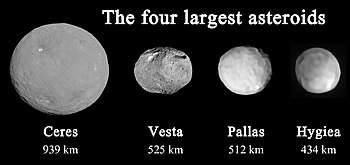
Both Vesta and Pallas have assumed the title of second-largest asteroid from time to time.[44] At 512±3 km in diameter,[10] Pallas is slightly smaller than Vesta (525.4±0.2 km[45]). The mass of Pallas is 78%±5% that of Vesta, 20%–23% that of Ceres, and a quarter of one percent that of the Moon.
Pallas is farther from Earth and has a much lower albedo than Vesta, and hence is dimmer as seen from Earth. Indeed, the much smaller asteroid 7 Iris marginally exceeds Pallas in mean opposition magnitude.[46] Pallas's mean opposition magnitude is +8.0, which is well within the range of 10×50 binoculars, but, unlike Ceres and Vesta, it will require more-powerful optical aid to view at small elongations, when its magnitude can drop as low as +10.6. During rare perihelic oppositions, Pallas can reach a magnitude of +6.4, right on the edge of naked-eye visibility.[17] During late February 2014 Pallas shone with magnitude 6.96.[47]
Pallas is a B-type asteroid.[10] Based on spectroscopic observations, the primary component of the material on Pallas's surface is a silicate containing little iron and water. Minerals of this type include olivine and pyroxene, which are found in CM chondrules.[48] The surface composition of Pallas is very similar to the Renazzo carbonaceous chondrite (CR) meteorites, which are even lower in hydrous minerals than the CM type.[49] The Renazzo meteorite was discovered in Italy in 1824 and is one of the most primitive meteorites known.[50] Pallas's visible and near-infrared spectrum is almost flat, being slightly brighter in towards the blue. There is only one clear absorption band in the 3-micron part, which suggests an anhydrous component mixed with hydrated CM-like silicates.[10]
Very little is known of Pallas's surface features. Hubble images from 2007, with a resolution around 70 kilometres (43 mi) per pixel, show pixel-to-pixel variation, but Pallas's albedo of 0.12 placed such features at the lower end of detectability. There is little variability between lightcurves obtained through visible-light and infrared filters, but there are significant deviations in the ultraviolet, suggesting large surface or compositional features near 285° (75° west longitude). Pallas's rotation appears to be prograde.[34]
Pallas is thought to have undergone at least some degree of thermal alteration and partial differentiation,[34] which suggests that it is a remnant protoplanet. During the planetary formation stage of the Solar System, objects grew in size through an accretion process to approximately this size. Many of these objects were incorporated into larger bodies, which became the planets, whereas others were destroyed in collisions with other protoplanets. Pallas and Vesta are likely survivors from this early stage of planetary formation.[51]
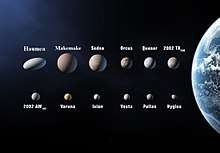
Pallas was on a "watchlist" of objects possibly meeting a provisional definition of "planet" in an early draft of the IAU's 2006 definition of planet.[53]
Satellites
A small moon about 1 kilometer in diameter was suggested based on occultation data from 29 May 1978. In 1980, speckle interferometry suggested a much larger satellite, whose existence was later refuted a few years later with occultation data.[54]
Exploration
Pallas has not been visited by spacecraft. A flyby after the Dawn probe's visits to 4 Vesta and 1 Ceres was discussed but was not possible.[55] The proposed Athena SmallSat mission, if funded, would be launched in 2022 as a secondary payload of the Psyche mission and would travel on separate trajectory to a flyby encounter with 2 Pallas.[56][57]
Gallery
- False-color image of Pallas
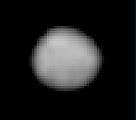 An ultraviolet image of Pallas showing its flattened shape, taken by the Hubble Space Telescope in 2007
An ultraviolet image of Pallas showing its flattened shape, taken by the Hubble Space Telescope in 2007 Lightcurve model of Pallas
Lightcurve model of Pallas
See also
- Objects formerly considered planets
- Pallas in fiction
Notes
- Calculated using the known dimensions assuming an ellipsoid.
- 1.010 ± 0.065) × 10−10 M☉
- Calculated using the mean radius
- Unicode value U+26B4
References
- The craters covering Pallas, here only faintly discernible, are likely to look much sharper if the view were closer, as can be seen in this comparison of VLT and Dawn images of 4 Vesta.
- "2 Pallas". Minor Planet Center. Retrieved 1 June 2018.
- "Pallas". Dictionary.com Unabridged. Random House.
- Schmadel, Lutz D. (2007). "(2) Pallas". Dictionary of Minor Planet Names. Springer Berlin Heidelberg. p. 15. doi:10.1007/978-3-540-29925-7_3. ISBN 978-3-540-00238-3.
- "Asteroid 2 Pallas". Small Bodies Data Ferret. Retrieved 24 October 2019.
- "Palladian". Oxford English Dictionary (3rd ed.). Oxford University Press. September 2005. (Subscription or UK public library membership required.)
- "JPL Small-Body Database Browser: 2 Pallas" (2018-01-23 last obs.). Jet Propulsion Laboratory. Retrieved 1 June 2018.
- "The MeanPlane (Invariable plane) of the Solar System passing through the barycenter". 3 April 2009. Archived from the original on 20 April 2009. Retrieved 10 April 2009. (produced with Solex 10 Archived 20 December 2008 at the Wayback Machine written by Aldo Vitagliano; see also invariable plane). Retrieved 25 April 2009.
- "AstDyS-2 Pallas Synthetic Proper Orbital Elements". Department of Mathematics, University of Pisa, Italy. Retrieved 1 October 2011.
- Carry, B.; et al. (2009). "Physical properties of (2) Pallas". Icarus. 205 (2): 460–472. arXiv:0912.3626. Bibcode:2010Icar..205..460C. doi:10.1016/j.icarus.2009.08.007.
- Surface-area calculation using Wolfram Alpha
- Volume calculation using Wolfram Alpha
- Baer, James; Chesley, Steven; Matson, Robert (2011). "Astrometric masses of 26 asteroids and observations on asteroid porosity". The Astronomical Journal. 141 (5). Bibcode:2011AJ....141..143B. doi:10.1088/0004-6256/141/5/143.
- "LCDB Data for (2) Pallas". Asteroid Lightcurve Database (LCDB). Retrieved 1 June 2018.
- Tedesco, E. F.; Noah, P. V.; Noah, M.; Price, S. D. (October 2004). "IRAS Minor Planet Survey V6.0". NASA Planetary Data System. 12: IRAS-A-FPA-3-RDR-IMPS-V6.0. Bibcode:2004PDSS...12.....T. Retrieved 30 October 2019.
- Neese, C., ed. (2005). "Asteroid Taxonomy. EAR-A-5-DDR-Taxonomy-V5.0". NASA Planetary Data System. Archived from the original on 5 August 2009. Retrieved 15 March 2007.
- Menzel, Donald H.; Pasachoff, Jay M. (1983). A Field Guide to the Stars and Planets (2nd ed.). Boston, MA: Houghton Mifflin. p. 391. ISBN 978-0-395-34835-2.
- Calculated with JPL Horizons for 1608-Feb-15
- Hilton, James L. "When did the asteroids become minor planets?". Astronomical Applications Department. US Naval Observatory. Retrieved 27 March 2019.
- Anonymous. "Space Topics: Asteroids and Comets, Notable Comets". The Planetary Society. Archived from the original on 16 May 2008. Retrieved 28 June 2008.
- René Bourtembourg (2012). "Messier's Missed Discovery of Pallas in April 1779". Journal for the History of Astronomy. 43 (2): 209–214. Bibcode:2012JHA....43..209B. doi:10.1177/002182861204300205.
- Hoskin, Michael (26 June 1992). "Bode's Law and the Discovery of Ceres". Observatorio Astronomico di Palermo "Giuseppe S. Vaiana". Retrieved 5 July 2007.
- Forbes, Eric G. (1971). "Gauss and the Discovery of Ceres". Journal for the History of Astronomy. 2 (3): 195–199. Bibcode:1971JHA.....2..195F. doi:10.1177/002182867100200305.
- "Astronomical Serendipity". NASA JPL. Archived from the original on 6 February 2012. Retrieved 15 March 2007.
- Hilton, James L. (16 November 2007). "When did asteroids become minor planets?". U.S. Naval Observatory. Archived from the original on 21 September 2007. Retrieved 5 February 2014.
- Hilton, James L. "Asteroid Masses and Densities" (PDF). U.S. Naval Observatory. Archived (PDF) from the original on 19 August 2008. Retrieved 7 September 2008.
- "Golf Ball World". Retrieved 24 February 2020.
- Kozai, Yoshihide (29 November – 3 December 1993). "Kiyotsugu Hirayama and His Families of Asteroids (invited)". Proceedings of the International Conference. Sagamihara, Japan: Astronomical Society of the Pacific. Bibcode:1994ASPC...63....1K.
- Faure, Gérard (20 May 2004). "Description of the System of Asteroids". Astrosurf.com. Archived from the original on 2 February 2007. Retrieved 15 March 2007.
- Foglia, S.; Masi, G. (1999). "New clusters for highly inclined main-belt asteroids". The Minor Planet Bulletin. 31 (4): 100–102. Bibcode:2004MPBu...31..100F. Archived from the original on 19 July 2011. Retrieved 15 March 2007.
- Drummond, J. D.; Cocke, W. J. (1989). "Triaxial ellipsoid dimensions and rotational pole of 2 Pallas from two stellar occultations" (PDF). Icarus. 78 (2): 323–329. Bibcode:1989Icar...78..323D. CiteSeerX 10.1.1.693.7435. doi:10.1016/0019-1035(89)90180-2.
- Dunham, D. W.; et al. (1990). "The size and shape of (2) Pallas from the 1983 occultation of 1 Vulpeculae". Astronomical Journal. 99: 1636–1662. Bibcode:1990AJ.....99.1636D. doi:10.1086/115446.
- Pitjeva, E. V. (2004). "Estimations of masses of the largest asteroids and the main asteroid belt from ranging to planets, Mars orbiters and landers". 35th COSPAR Scientific Assembly. Held 18–25 July 2004, in Paris, France. p. 2014. Bibcode:2004cosp...35.2014P.
- Schmidt, B.E.; Thomas, P.C.; Bauer, J.M.; Li, J.-Y.; McFadden, L.A.; Parker, J.M.; Rivkin, A.S.; Russell, C.T.; Stern, S.A. (2008). "Hubble takes a look at Pallas: Shape, size, and surface" (PDF). 39th Lunar and Planetary Science Conference (Lunar and Planetary Science XXXIX). Held 10–14 March 2008, in League City, Texas. 1391 (1391): 2502. Bibcode:2008LPI....39.2502S. Archived (PDF) from the original on 4 October 2008. Retrieved 24 August 2008.
- Staff (24 October 2007). "Hubble Images of Asteroids Help Astronomers Prepare for Spacecraft Visit". JPL/NASA. Archived from the original on 9 June 2007. Retrieved 27 October 2007.
- James, Andrew (1 September 2006). "Pallas". Southern Astronomical Delights. Retrieved 29 March 2007.
- "Athena". Encyclopædia Britannica (1911 ed.). Encyclopædia Britannica (Tim Starling). Retrieved 16 August 2008.
- Dietrich, Thomas (2005). The Origin of Culture and Civilization: The Cosmological Philosophy of the Ancient Worldview Regarding Myth, Astrology, Science, and Religion. Turnkey Press. p. 178. ISBN 978-0-9764981-6-2.
- The one exception internationally to the use of Pallas/Pallad- as the name of the asteroid is Chinese, where it is known as 智神星 Zhìshénxīng, the 'wisdom-god star'
- "Palladium". Los Alamos National Laboratory. Archived from the original on 5 April 2007. Retrieved 28 March 2007.
- Goffin, E. (2001). "New determination of the mass of Pallas". Astronomy and Astrophysics. 365 (3): 627–630. Bibcode:2001A&A...365..627G. doi:10.1051/0004-6361:20000023.
- Taylor, D. B. (1982). "The secular motion of Pallas". Monthly Notices of the Royal Astronomical Society. 199 (2): 255–265. Bibcode:1982MNRAS.199..255T. doi:10.1093/mnras/199.2.255.
- "Solex by Aldo Vitagliano". Archived from the original on 20 December 2008. Retrieved 19 March 2009. (numbers generated by Solex)
- "Notable Asteroids". The Planetary Society. 2007. Archived from the original on 16 April 2007. Retrieved 17 March 2007.
- Russell, C. T.; et al. (2012). "Dawn at Vesta: Testing the Protoplanetary Paradigm". Science. 336 (6082): 684–686. Bibcode:2012Sci...336..684R. doi:10.1126/science.1219381. PMID 22582253.
- Odeh, Moh'd. "The Brightest Asteroids". Jordanian Astronomical Society. Archived from the original on 13 August 2007. Retrieved 16 July 2007.
- Calculated with JPL Horizons for 2014-Feb-24
- Feierberg, M. A.; Larson, H. P.; Lebofsky, L. A. (1982). "The 3 Micron Spectrum of Asteroid 2 Pallas". Bulletin of the American Astronomical Society. 14: 719. Bibcode:1982BAAS...14..719F.
- Sato, Kimiyasu; Miyamoto, Masamichi; Zolensky, Michael E. (1997). "Absorption bands near 3 m in diffuse reflectance spectra of carbonaceous chondrites: Comparison with asteroids". Meteoritics. 32 (4): 503–507. Bibcode:1997M&PS...32..503S. doi:10.1111/j.1945-5100.1997.tb01295.x.
- "Earliest Meteorites Provide New Piece in Planetary Formation Puzzle". Particle Physics and Astronomy Research Council. 20 September 2005. Archived from the original on 6 May 2013. Retrieved 24 May 2006.
- McCord, T. B.; McFadden, L. A.; Russell, C. T.; Sotin, C.; Thomas, P. C. (2006). "Ceres, Vesta, and Pallas: Protoplanets, Not Asteroids". Transactions of the American Geophysical Union. 87 (10): 105. Bibcode:2006EOSTr..87..105M. doi:10.1029/2006EO100002.
- Gingerich, Owen (16 August 2006). "The Path to Defining Planets" (PDF). Harvard-Smithsonian Center for Astrophysics and IAU EC Planet Definition Committee chair. p. 4. Retrieved 13 March 2007.
- Rincon, Paul (16 August 2006). "Planets plan boosts tally to 12". BBC News. Archived from the original on 2 March 2007. Retrieved 17 March 2007.
- Johnston, William Robert (5 March 2007). "Other Reports of Asteroid/TNO Companions". Johnson's Archive. Archived from the original on 10 February 2007. Retrieved 14 March 2007.
- Perozzi, Ettore; Rossi, Alessandro; Valsecchi, Giovanni B. (2001). "Basic targeting strategies for rendezvous and flyby missions to the near-Earth asteroids". Planetary and Space Science. 49 (1): 3–22. Bibcode:2001P&SS...49....3P. doi:10.1016/S0032-0633(00)00124-0.
- Dorminey, Bruce (10 March 2019). "Proposed NASA SmallSat Mission Could Be First To Visit Pallas, Our Third Largest Asteroid". Forbes. Retrieved 10 March 2019.
- Athena: the first-ever encounter of (2) Pallas with a Smallsat. J. G. O'Rourke, J. Castillo-Rogez, L. T. Elkins-Tanton, R. R. Fu, T. N. Harrison, S. Marchi, R. Park, B. E. Schmidt, D. A. Williams, C. C. Seybold, R. N. Schindhelm, J. D. Weinberg. 50th Lunar and Planetary Science Conference 2019 (LPI Contrib. No. 2132).
External links
| Look up Pallas in Wiktionary, the free dictionary. |
| Wikimedia Commons has media related to (2) Pallas. |
- Pallas at Encyclopædia Britannica, Edward F. Tedesco
- Mona Gable. "Study of first high-resolution images of Pallas confirms asteroid is actually a protoplanet". University of California, Los Angeles (UCLA). Archived from the original on 15 October 2009. Retrieved 20 October 2009.
- Jonathan Amos (11 October 2009). "Pallas is 'Peter Pan' space rock". BBC. Archived from the original on 19 July 2010. Retrieved 19 August 2010.
- "2 Pallas". JPL Small-Body Database Browser. Retrieved 29 March 2007.
- Dunn, Tony (2006). "Ceres, Pallas Vesta and Hygeia". GravitySimulator.com. Archived from the original on 13 March 2007. Retrieved 15 March 2007.
- Hilton, James L. (1 April 1999). "U.S. Naval Observatory Ephemerides of the Largest Asteroids". U.S. Naval Observatory. Retrieved 14 March 2007.
- Tedesco, Edward F.; Noah, Paul V.; Noah, Meg; Price, Stephan D. (2002). "The Supplemental IRAS Minor Planet Survey". The Astronomical Journal. 123 (2): 1056–1085. Bibcode:2002AJ....123.1056T. doi:10.1086/338320.
- 2 Pallas at AstDyS-2, Asteroids—Dynamic Site
- 2 Pallas at the JPL Small-Body Database
